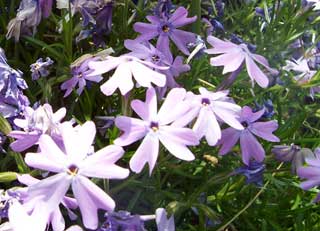The Groundcover From the Green Lagoon: Creeping Phlox
 If there is one thing I have learned over the years is that gardeners in general really need to take a few Public Relations classes before they go giving plants common names. Toad Lily? Lungwort? Butterfly Weed? Who thinks these names would encourage people to put these plants in their garden?
If there is one thing I have learned over the years is that gardeners in general really need to take a few Public Relations classes before they go giving plants common names. Toad Lily? Lungwort? Butterfly Weed? Who thinks these names would encourage people to put these plants in their garden?
I think at the very least the the nursery industry should get involved and petition or something. These sorts of naming conventions are hurting their business.
Anyhoo, I think creeping phlox is one of these poorly named plants. Creeping? Scary monsters creep. Bad guys creep. Pretty flowering groundcovers do not creep. OK, it does creep but not in creepy, out to kill you sort of way.
Creeping phlox is actually a native Eastern US plant but it will grow just about anywhere in the United States. It will grow happily from zone 3-9 and is recommended for all kinds of gardening types from shade gardening to xeriscaping. Needless to say, creeping phlox is one hardy plant.
One of the best loved features about creeping phlox is that it will spread, but is not so brutish as to be invasive about it. It will cover an area quite nicely and will politely step around anything already growing there.
One bonus I have found with creeping phlox is that it makes an ideal groundcover to mix with bulb plantings. The cheeping phlox creates a cover that is solid to the eye but not matted to the ground. Because of this, bulbs can come up very nicely through the phlox, look magnificent and then, just about the time their blooms fade, the phlox comes to its full glory, which helps detract from the bulb’s greenery sticking out above. Then for the rest of the year the creeping phlox serves as a nice backdrop to the rest of the garden.
Apparently, I am not the only one who thinks that creeping phlox is a poor name for such a lovely plant. In some areas, creeping phlox is referred to as “moss pink”, though I would like to point out that it is neither moss nor always pink.
